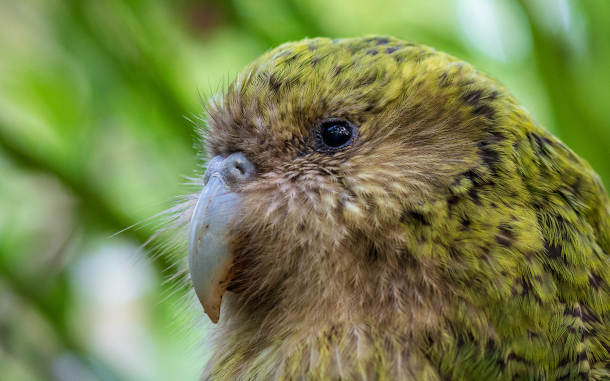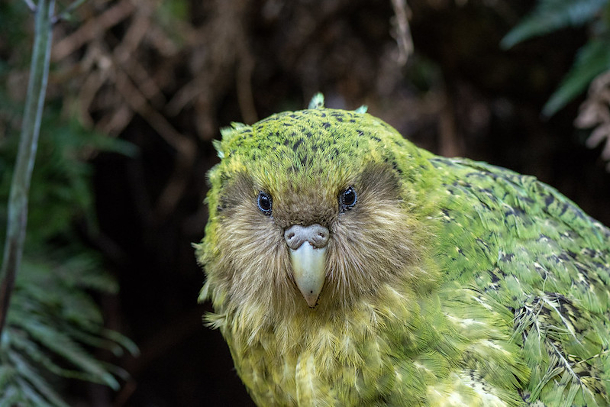BirdNote®: New Zealand’s Kakapo
Air Date: Week of September 11, 2020

Kakapos are big, flightless birds that nevertheless manage to clamber up the trees of New Zealand’s forests. (Photo: © Jake Osborne)
Islands are famously home to a huge diversity of animals found nowhere else on Earth. In New Zealand, an edemic and peculiar bird called the Kakapo is making a comeback. BirdNote’s Michael Stein reports on this one-of-a-kind big bird.
Transcript
BASCOMB: Islands are famously home to a huge diversity of endemic animals, found nowhere else on earth. Think of lemurs in Madagascar, Giant Tortoises in the Galapagos, or Kangaroos in Australia. And from New Zealand BirdNote’s Michael Stein has yet another example of an island producing a one-of-a-kind animal.
BirdNote®
New Zealand’s Kakapo
New Zealand is home to some very unusual birds—the kiwis for example. But none is more peculiar than the Kakapo. [Kakapo male call, https://www.doc.govt.nz/globalassets/documents/conservation/native-anima... The Kakapo is a kind of parrot, but one that doesn’t fly. At five pounds, it’s the world’s heaviest parrot. But being heavy and flightless doesn’t stop a Kakapo from getting up a tree. It uses its strong claws and beak to grip the bark and pull itself up. [Kakapo female call, https://www.doc.govt.nz/globalassets/documents/conservation/native-anima...

Kakapos are highly endangered but making a comeback. (Photo: © Jake Osborne)
Like many parrots, Kakapos are long-lived -- up to ninety years. Still, they’re highly endangered. These odd parrots evolved in an island world that lacked terrestrial predators. But all that changed when humans and their animals arrived. Now Kakapos are mostly consigned to a conservation recovery program on small islands that are free of predators. Things are looking up though. The Kakapo population has grown 70% in the past five years. Even though there are only about 200 Kakapos out there, that’s still more than at any time in the past seventy years. The next challenge? Find more safe habitat for the growing population of these one-of-a-kind parrots.
[Kakapo male call, https://www.doc.govt.nz/globalassets/documents/conservation/native-anima...
###
Written by Bob Sundstrom
Producer: John Kessler
Executive Producer: Sallie Bodie
Editor: Ashley Ahearn
Associate Producer: Ellen Blackstone
Assistant Producer: Mark Bramhill
Bird sounds courtesy of New Zealand Government Department of Conservation, https://www.doc.govt.nz/nature/native-animals/birds/birds-a-z/kakapo/
BirdNote’s theme was composed and played by Nancy Rumbel and John Kessler.
© 2020 BirdNote March 2020 Narrator: Michael Stein
ID# kakapo-01-2020-03-18 kakapo-01
[lots of information at this site: https://www.doc.govt.nz/kakapo-recovery]
https://www.doc.govt.nz/news/media-releases/2019/kakapo-population-reach...
https://www.google.com/amp/s/phys.org/news/2015-11-rimu-berry-game-chang...
https://www.birdnote.org/show/new-zealands-kakapo
BASCOMB: For pictures hop on over to the Living on Earth website, LOE dot Org
Links
Find this story and more on the BirdNote® website
Watch a short BBC video about “the cute and clumsy flightless parrot”
Living on Earth wants to hear from you!
Living on Earth
62 Calef Highway, Suite 212
Lee, NH 03861
Telephone: 617-287-4121
E-mail: comments@loe.org
Newsletter [Click here]
Donate to Living on Earth!
Living on Earth is an independent media program and relies entirely on contributions from listeners and institutions supporting public service. Please donate now to preserve an independent environmental voice.
NewsletterLiving on Earth offers a weekly delivery of the show's rundown to your mailbox. Sign up for our newsletter today!
 Sailors For The Sea: Be the change you want to sea.
Sailors For The Sea: Be the change you want to sea.
 The Grantham Foundation for the Protection of the Environment: Committed to protecting and improving the health of the global environment.
The Grantham Foundation for the Protection of the Environment: Committed to protecting and improving the health of the global environment.
 Contribute to Living on Earth and receive, as our gift to you, an archival print of one of Mark Seth Lender's extraordinary wildlife photographs. Follow the link to see Mark's current collection of photographs.
Contribute to Living on Earth and receive, as our gift to you, an archival print of one of Mark Seth Lender's extraordinary wildlife photographs. Follow the link to see Mark's current collection of photographs.
 Buy a signed copy of Mark Seth Lender's book Smeagull the Seagull & support Living on Earth
Buy a signed copy of Mark Seth Lender's book Smeagull the Seagull & support Living on Earth

